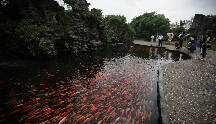Travel Tips
Snow Mountains
The Gongga Southwestern Slope Scenic Area is in Kangding County, consisting of the Sinter Terrace of the Yulong Stream, Hot Springs, Gongga Temple, Bawang Glacier, and Virgin Forest.
The Yulong Stream and Ribujiao are picturesque, featuring alpine grasslands and colorful sinter lakes. In summer and autumn, the grassland is green and wild flowers in full bloom form a brilliant brocade.
Gongga Temple is an ancient Tibetan Buddhist temple, close to Gongga's main peak. It is the best place to view Mount Gongga, as well as see the sunrise and a sea of clouds.
The Gongga Southwestern Slope Scenic Area is an ideal place to conduct scientific investigations into geography, biology and climatology, and also the only way to Mount Gongga from the western slope. Pilgrims to Gongga Temple come through here in an endless stream.
Interestingly, the folk customs of Tibetan inhabitants on the two sides of Mount Gongga are quite different. Tibetans east of Mount Gongga lead a modern lifestyle, while those west of Mount Gongga have preserved their ancient folklore.
The best period to climb the Daxue Mountains is in May and June, at the turn of the dry and rainy seasons. During this period temperatures are high and precipitation is not great.
Mount Namjagbarwa
Seeing Namjagbarwa, the most beautiful mountain in China, is a good reason to visit Tibet. Located in humid Nyingchi Prefecture, the mountain is often shrouded in mist and clouds.
Reaching up to 7,782 meters above sea level, Namjagbarwa is the highest peak of the eastern section of the Himalayas, and the 15th highest peak in the world. It is known as the "father of ice-topped mountains." The Yarlung Zangbo Grand Canyon in Medog County is the world's largest canyon. The high mountain and deep canyon together form the Namjagbarwa Scenic Area. The area has multiple functions, such as tourism, mountaineering, adventuring and drifting. It is also a good place to conduct scientific investigations.
The area along the Yarlung Zangbo Grand Canyon has a complicated geological structure, and the plate movements here are strong, causing frequent earthquakes and snow avalanches. As a result, Mount Namjagbarwa was not conquered until 1992, when a Sino-Japanese joint mountaineering team reached the top.
Namjagbarwa has several meanings in the Tibetan language. One is a "long lance piercing the sky," and another is "burning thunder and lightning."
The mountain is the source of many legends. It is said the gods often gather on its top and hold weisang ceremonies, in which Tibetans burn pine branches to produce smoke. The local people believe that the banner-shaped clouds are smoke produced by these ceremonies. It is said that on the mountaintop there is a road leading to the celestial palace and heaven. Locals consequently admire and worship the peak.
From the top of Namjagbarwa to Pasighat – 200 kilometers as the crow flies – one can experience vertical climatic changes from frigidity to tropical rainforest down the southern slopes, and see alpine shrubbery and a grassy belt in the frigid zone, conifers in the cold temperate zone, and broadleaf trees and confiners in the warm temperate zone.
Travel Tips
The best season to view Namjagbarwa is autumn, when the upper airflow is stable and vapor concentration lowest, providing more opportunities to take pictures of the peak. There are two good places to view Namjagbarwa. One is Sejila Pass, on the Sichuan-Tibet Highway between Bome and Bayi Town. But it is a long way from the mountain. Another viewing spot is at the entrance to the gully. In addition, several villages, such as Daduka, Zhibai and Gega, are good places to take pictures of Namjagbarwa, especially the entrance to Zhibai Village, which is just ten kilometers from the mountain. From here one can fully appreciate the charm of this snowy peak

